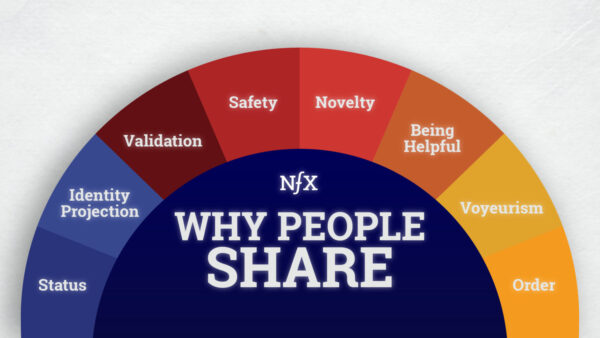Too often, we miss the forest for the trees — we focus overly on A/B testing, optimizing conversion funnels and landing pages and app designs, while not focusing enough on the psychological and language fundamentals that motivate our users to share our product (or not).
Understanding and applying the psychology of why people share is the Pareto Principle of marketing — it’s the 20% of what you do marketing and product design that will ultimately lead to 80% of the growth.
Origen: NfX – Why People Share: The Psychology Behind “Going Viral”

One of our goals at NFX is to encourage more founders to build network effects businesses. We hope helping you think through why people share will guide you down this path.
Baseline Viral Thinking
Each of the motivations we discuss below may or may not apply to your product. But there are several things that always apply.
First, is our pack animal psychology. As a pack animal, we’re constantly thinking about our status, how we’re perceived, where we fit in, etc. Those constant mental loops serve as the foundation of our motivations to share. We all worry about how sharing will make us look.
Second, reduce the friction to sharing. Design your product so that it minimizes the effort and thinking required to share.
Third, think about how to make your product broken unless people share. If they can’t get the utility that they want, they will look for ways to share.
Fourth, make your language about the user, not about you. This is very challenging for most product people, who are proud of what they have built and want to be recognized by users for their accomplishments. But this is juvenile. As product people and marketers, you have to transcend your own self-interest in favor of your users’ own self-interest. It’s more generous and more effective.
In short, when any of us consider sharing something online or offline, we unconsciously make a trade-off between benefit and costs:
- How might sharing this benefit me (the sharer) or you (the audience/recipient) either via utility or via status/reputation?
- How much time and effort (friction) will I have to spend to share this?
8 Clusters of Motivation That Trigger Sharing
Here are 8 motivations that trigger sharing. There are more, but these give you a good starting point. If you want to do more research, track down writings on the subject by Freud, Maslow, McClelland, Murray, Costa & McCrae, and Erhard.
With each cluster, we’ve chosen a word that we think best represents a cluster of words that speak to this core motivation. In each case, we list the other terms we’ve found similar. We include them all because each word could trigger a different idea in your mind as you think about how it could apply to your product.
1. Status
This is the big one. It can also be termed “belonging,” “prestige,” “respect,” “scarcity” or “in-the-know”. People often try to show this by associating themselves with other high-status people or central nodes in the network. Most of us intuitively understand that high-status nodes in a network tend to mostly associate with other high-status nodes.
2. Identity Projection
Other words in this cluster include: “tribalism,” “vindication,” and “confirmation bias”. We want to be able to show who we are and be vindicated in our identity. … When we express outrage around something, we’re drawing a clear line around what we aren’t.
3. Being Helpful
“Utility,” “Better,” “Cheaper”. We are compelled to share things that we find useful because we want to be perceived as helpful and nurturing to our tribes. It feels good to be looked at as someone who is competent and knows what you’re doing. Whether that be a new product that we feel really improves our lives by producing a lot of value or something that produces that value at a lower price.
4. Safety
“Fear,” “Compliance,” “Prevent harm,” “Security”. Fear is embedded in the most primal part of our psychology. If we sense danger, our brain has evolved to pay attention. Any perceived threat to safety —whether physical, financial, or emotion— can be a powerful reason why people share. News media have long understood this. As they say in the biz, “If it bleeds, it leads.”
5. Order
“Organize,” “Collect”. One of the Big Five personality traits is conscientiousness — people fall on a spectrum between personality types that like to be highly organized and efficient and those who are naturally messier. People who are trying to organize their world because of their personality are highly motivated to share tools that help them to optimize and organize.
6. Novelty
“Entertainment,” “The new”. Another aspect of personality identified as part of the Big Five is openness to experience — where we fall on a spectrum of being driven by seeking novelty and curiosity to being cautious and preferring familiarity. The attraction of novelty was identified early on by Wilhelm Wundt, one of the founders of modern psychology who came up with the Wundt curve —a bell-curve distribution between novelty at one end and familiarity at the other.nThe sweet spot is in the middle— we are attracted by things that are new enough to not be stale, but not too new to be strange. …We are motivated to share new products and new information because it makes us look like we’re ahead of the (Wundt) curve.
7. Validation
“Positive,” “Happy,” “Smart”. A lot of what we share online has to do with the fact that we want to get a boost, believe we are good, believe we’re smart, or believe we’re worthy. We want to feel positive about ourselves and our place in the world.
8. Voyeurism
“Window,” “Schadenfreude,” “Access”. There are two related motivations that cause people to share out of voyeurism.
On the one hand, you have vicarious enjoyment. On the other hand, there’s schadenfreude.
…it’s two sides of the same coin. Voyeurism is a powerful motivation in why people share.
Always Return to the Psychology
As a Founder, understanding the psychology of why people share is one of the keys to unlocking growth. Experimenting with language to connect with these motivations is the work to be done.
Too often, we miss the forest for the trees — we focus overly on A/B testing, optimizing conversion funnels and landing pages and app designs, while not focusing enough on the psychological and language fundamentals that motivate our users to share our product (or not).
Understanding and applying the psychology of why people share is the Pareto Principle of marketing — it’s the 20% of what you do marketing and product design that will ultimately lead to 80% of the growth.
